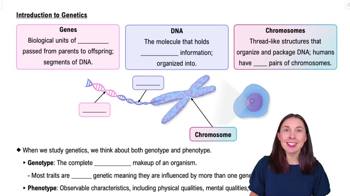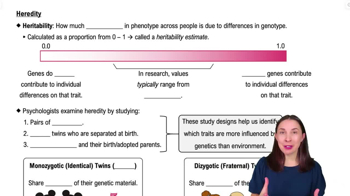Table of contents
- 1. Introduction to Psychology1h 43m
- 2. Psychology Research2h 20m
- 3. Biological Psychology2h 41m
- 4. Sensation and Perception28m
- 5. Consciousness and Sleep32m
- 6. Learning41m
- 7. Memory34m
- 8. Cognition37m
- 9. Emotion and Motivation35m
- 10. Developmental Psychology33m
- 11. Personality48m
- 12. Social Psychology41m
- 13. Stress and Health41m
- 14. Psychological Disorders44m
- 15. Treatment47m
3. Biological Psychology
Genes and Environment
Struggling with Psychology?
Join thousands of students who trust us to help them ace their exams!Watch the first videoMultiple Choice
Why are studies with twins useful in psychology?
A
They allow researchers to “control” for genetics or the environment.
B
They allow researchers to work with twice as many subjects.
C
They allow researchers to have a control group.
D
They allow researchers to have an experimental group.
 Verified step by step guidance
Verified step by step guidance1
Understand the concept of twin studies: Twin studies are a type of genetic research used to determine the influence of genetics and environment on human traits and behaviors.
Identify the types of twins: Monozygotic (identical) twins share 100% of their genes, while dizygotic (fraternal) twins share about 50% of their genes, similar to regular siblings.
Recognize the purpose of twin studies: By comparing similarities and differences between monozygotic and dizygotic twins, researchers can estimate the relative contributions of genetic and environmental factors.
Consider the control for genetics: Since identical twins have the same genetic makeup, any differences in traits or behaviors can be attributed to environmental factors, allowing researchers to 'control' for genetics.
Evaluate the control for environment: If twins are raised in different environments, researchers can assess how different environments impact traits, providing insights into environmental influences.

 4:01m
4:01mWatch next
Master Introduction to Genetics with a bite sized video explanation from Hannah Gordils
Start learningRelated Videos
Related Practice





























